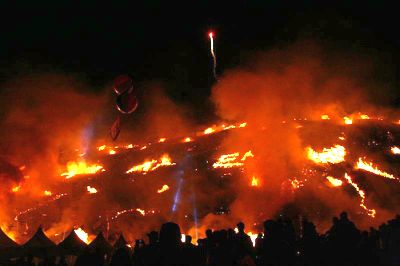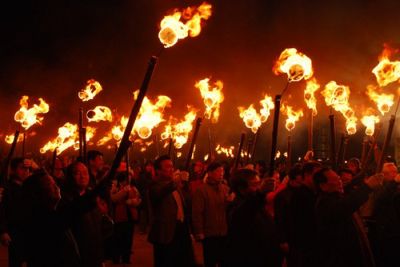Burning Down The Neighborhood: The Jeju Fire Festival
By Matt Scott
The Fire Festival had all the hallmarks of a one-off event: terrible parking in a muddy field, traders selling glow-in-the-dark necklaces, mobile food vendors, and music blaring over a P.A. system. Before I even entered the festival area I was cold and caked in mud having queued up for 20 minutes to buy a Korean interpretation of the hot dog: boiled fish on a skewer. It had been a long drive through the hills of Jeju Island to find the site, but the long queue of cars on the normally quiet roads had helped everyone find the right spot.
I had spent three months teaching English in an undergraduate school close to Seoul and was only just beginning to really appreciate the intricacies and richness of Korean culture and history. The school’s head professor, Dr. Sahn, had arranged a weekend trip to the southern island of Jeju to show the foreign teachers a different area of the country and to allow us to take part in a national celebration. Jeju Island, the remnant of a long extinct volcano, is a popular holiday spot in Korea. Its incredible mountains, beautiful beaches, and unique culture and history make it popular for Korean and international travelers alike. People come from around the world for its national park featuring waterfalls, caves, stunning cliffs, ocean views, and Korea’s second highest mountain, Mt. Halla.
Jeju — known as the Hawaii of Korea due to its warm climate and constant sea temperature — was well above freezing (while most of the mainland was experiencing heavy snowstorms). Our visit was timed to coincide with the first full moon of the lunar New Year as Jeju was the perfect place to see the Jeongwol Daeboreum Fire Festival. The festival dates back hundreds of years when farmers used to burn their fields to rid their land of disease, drive away the past year, and to pray for good fortune and bumper crops in the next year. The festival was banned in the middle of the 70’s as part of Korea’s fire prevention policy, but due to local outcry it was revived in 1997.
“There are fire festivals all over the country,” explained Dr. Sahn, “but Jeju’s is the best. Today is the third and last day here, and the end of the festival is always the best. That is when the fire comes.”
Thousands of people have come from all over Jeju to visit this festival and many have flown over from the mainland to witness one of the most impressive displays in the country. Folk dancing, traditional crafts, song contests, drama performances and even traditional wedding ceremonies take place before the full moon, with the final night attracting the largest crowds. The festival was just about to finish when we arrived, and I saw crowds on the side of Saebyeol oreum — the area’s largest hill — apparently gathered for the best views of the infamous finale: the giant fire.
I made my way though the vendors selling food, drinks, and souvenirs, and into a vast open area that overlooked the valley. Fireworks set off from amongst the crowd exploded in the air, and children screamed as bangers went off on the ground, while others covered their ears and hid between the legs of their parents. Many people were playing with burning cans that were suspended on a long wire.
“This is a folk game. Jwibul nori we call it here,” explained a young man who was in the process of lighting each can and passing it to his friends. “We put a small fire in a tin can and swing it around on this wire.”
From a distance it seemed that large halos of fire were surrounding people, only to disappear as their arms grew tired and they rest the can back on the ground. As soon as they stop, people crowded round the tins, rubbing their hands to keep warm. As more fireworks were set off from the crowd, shouts and screams broke up the singing and dancing as people avoided a stray projectile. It whizzed through the crowd before exploding, without incident, next to one of the portable toilet blocks.
I could see a large, unlit bonfire that was built in the valley. Unimpressive to me, its size did not seem sufficient to warrant the size of audience gathered around. I was still unaware of what was about to happen and was a little disappointed to see a relatively small size of tinder and sticks. Even as a precession of burning torches made its way past the crowd and towards the bonfire, the 15-foot high pile of dry wood did not look as if it would be particularly exciting once ablaze.
The torch holders surrounded the fire. Dressed in white robes they resembled a medieval burning at the stake. The events had a rather eerie touch to it at first, but as a volleys of torches were thrown onto the bonfire, the crowd erupted into cheers and the festival atmosphere returned with a bang. Huge flames leaped upwards from the fire as it rapidly burned, and the torches quickly disappeared into the raging fire as the white robes made their rapid retreat.
Several large bangs suddenly echoed across the valley and flares exploded from the fire and streamed into the hill opposite the crowd. Where they landed, smaller fires began to burn, starting an impressive chain reaction: fireworks exploded from those fires, arching over the hill to land in areas further away, beginning small fires of their own. These fires then began to spread rapidly and consume the tinder on the hill. Within minutes, only a single, massive orange curtain of flame danced across the hill.
 With the exception of a few festival bonfires I had never seen a truly wild fire, and I was consumed by a perhaps primeval fascination of watching giant flames reach into the sky. What started as a small fire in the valley below now stretched its way to the very crest of the hill. Surprisingly, I could feel my body temperature rise as a result of the extreme heat from the flames penetrated hundreds of meters into the crowd.
With the exception of a few festival bonfires I had never seen a truly wild fire, and I was consumed by a perhaps primeval fascination of watching giant flames reach into the sky. What started as a small fire in the valley below now stretched its way to the very crest of the hill. Surprisingly, I could feel my body temperature rise as a result of the extreme heat from the flames penetrated hundreds of meters into the crowd.
I forced myself to turn away from the spectacle to consider what had happened. Had something gone terribly wrong? I looked across the crowd, expecting perhaps terror and panic, but the bright faces and cheers indicated otherwise. It was this that thousands of people had come to witness, not just a small bonfire and a few fireworks as I’d been expecting.
The fire burned rapidly and soon the cracking of the tinder and the flickering of the flames began to fade away. As the last of the flames disappeared into the blackness of the night, fireworks rocketed into the sky from the valley. On the crest of the hill dozens of people dressed in white robes swung fire cans, forming a line of fire rings stretching across the horizon. The hill has returned to a dark silhouette against the night sky but a fire in the middle of the hill still burned brightly. Korean letters spelling out “Happy New Year” glowed deep red against the black ashes surrounding it — the only remaining indication that anything had happened.
As the crowds dispersed and the last fireworks fell to earth, the embers on the hill finally faded into black. Above the hills was a bright, new moon, illuminating the mountains of Jeju and welcoming the start of new year.


